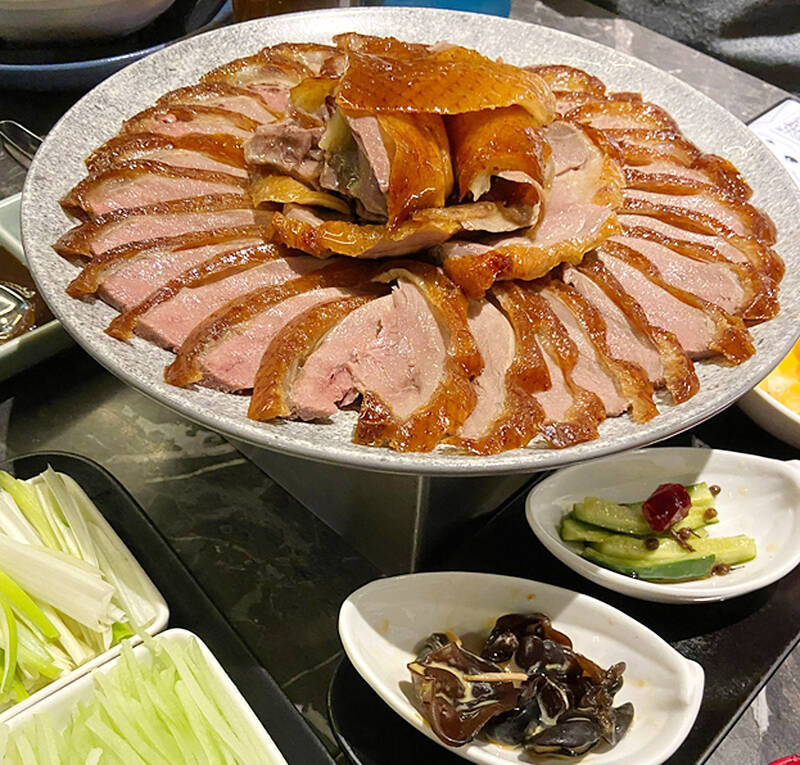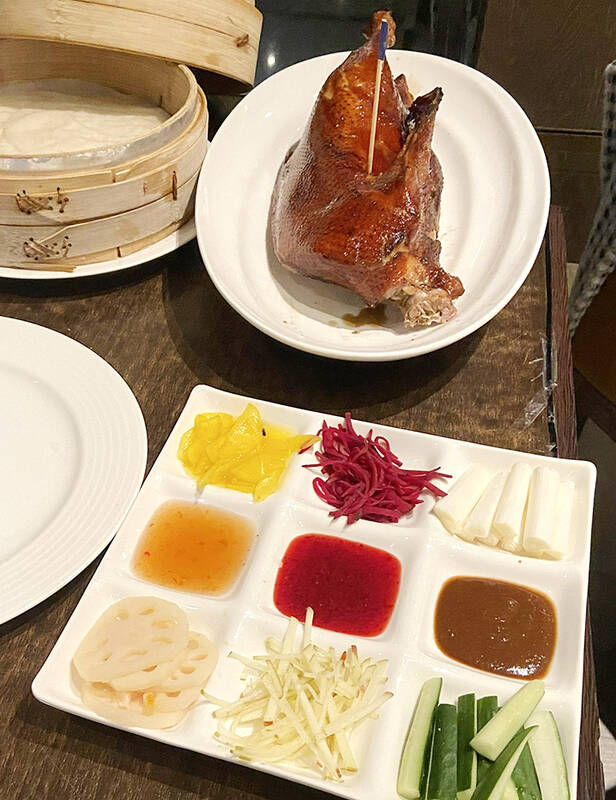Roast duck is a dish that reflects Taiwan’s diverse culinary style, shaped by its rich immigrant background. Originally brought to Taiwan by Chinese immigrants, roast duck has become an essential delicacy in Taiwanese cuisine. Restaurants specializing in roast duck are often packed at meal times. However, since these restaurants have only a limited number of roast ducks each day, reservations are necessary to ensure availability. Preparing a delicious roast duck is no easy feat, as it is a time-consuming process requiring half a day to cook to ensure the perfect taste.
台灣的移民背景造就豐富的飲食文化,烤鴨就是其中之一。烤鴨傳入台灣是由外省人引進的,隨著時間的紮根,成為了台灣不可或缺的美食。用餐時間的烤鴨店總是高朋滿座,但因每天限量供應,想吃還要提早訂,因為製作美味的烤鴨至少得花上半天,才能色香味俱全。
immigrant (n.) 移民

Photo courtesy of Bookman l 圖片:書林
reservation (n.) 預約,預定
Roast duck is not only delicious but also visually appealing. The skin has a dark amber color, covering its tender and succulent meat. Taiwan’s roast duck is famous for its “one duck, three ways” preparation, where the duck skin, meat and bones are cooked in different ways so diners can enjoy the taste of roast duck in all aspects. The first way involves eating the sliced duck meat in a thin flour wrapper. A sweet bean sauce is spread on the wrapper, then the meat with skin on and some scallions are added before it is wrapped up to be eaten in one bite. The second way to eat it involves stir-frying the meat on the bones and adding basil and soy sauce. The third way to eat it is duck soup, which is made with ginger slices and the remaining parts of the duck. These are the classic ways to savor roast duck.
烤鴨不僅美味,看上去也很誘人。烤鴨外皮為琥珀色,肉質鮮嫩多汁。台灣烤鴨以「一鴨三吃」為招牌吃法,將鴨皮、鴨肉和鴨架以三種方式烹調,全方面享受烤鴨的美味。首先是將帶皮的鴨肉切成薄片,抹上甜麵醬,和蔥段夾在薄麵皮中一口吃下。再來是將鴨架和九層塔大火爆炒,剩下的部分最後加薑片煮鴨湯,即為烤鴨的經典吃法。

Photo courtesy of Bookman l 圖片:書林
succulent (adj.) 多汁的
diner (n.) 用餐的人
savor (v.) 品味
Roast duck is a famous Chinese dish from northern China. Its history can be traced back to the period of the Northern and Southern Dynasties (420–589 CE). The preparation of the duck originated in Nanjing and later developed in Beijing during the Ming Dynasty, where it was served as imperial cuisine and eventually became today’s Peking duck that has influenced Taiwan’s food culture. Despite the abundance of delicious food in Taiwan, the excellent flavor of roast duck continues to be popular among numerous food enthusiasts.
烤鴨是中國經典的北方菜,起源於中國南北朝時期(公元420—589年),其料理方式原於南京,傳入北京後,於明朝發展成為宮廷御膳,成為如今的北京烤鴨,豐富了台灣的飲食文化。絕佳的風味讓烤鴨即便在美食琳瑯滿目的台灣,仍吸引許多老饕到餐廳大快朵頤
abundance (n.) 豐富;充足
enthusiasts (n.) 熱衷者,熱心者
文章由書林出版公司提供:
www.bookman.com.tw

A: What’s the theme of the 2025 Taiwan Lantern Festival’s main lantern? B: The theme is “Paradise,” and the main lantern is a snake-shaped “infinity” symbol that features a lighting show every half an hour. A: Cool, I heard that there are over 300 lanterns. B: There are even giant lanterns in the shape of Pikachu and some other popular Pokemon characters. A: Let’s go now. A: 2025台灣燈會主燈的主題是什麼? B: 主題是「無限樂園」!主燈的造型則是蛇形的數學「無限號」,主燈每半小時還有一次燈光秀。 A: 酷喔,聽說總共有300多件花燈作品。 B: 甚至還有皮卡丘和其他熱門寶可夢角色的巨型花燈呢。 A: 哇我們現在就出發吧! (By Eddy Chang, Taipei Times/台北時報張聖恩)

本文由生成式AI協作,本刊編輯編修。 Tucked away in southwestern Taiwan, Yunlin County is a treasure trove of cultural heritage, rich history, and natural beauty. From its stunning temples and glove puppetry to historical architecture and picturesque landscapes, Yunlin rewards those who venture off the beaten path. Yunlin is renowned for its flourishing temple culture. Temples in this region are not merely places of worship but also communal centers where people gather for festivals, rituals, and social functions. One of the most notable temples here is the Beigang Chaotian Temple, which was built more than 300 years ago and is dedicated to Matsu, the sea

After steel and aluminum, US President Donald Trump has set his sights on slapping 25 percent tariffs on semiconductors, cars and pharmaceuticals. Trump has already slapped additional 10 percent tariffs on goods from China and has also threatened tariffs on Canada and Mexico, plus ordered a study into putting into place reciprocal tariffs. Here’s a look who would be hit the hardest if US import tariffs on semiconductors, cars and pharmaceuticals go into force. SEMICONDUCTORS: ASIA IN THE CROSSHAIRS Semiconductors, or microchips, are the brains in our electronic devices and demand has soared with the development of AI, which

Nestled within the heart of Taipei, National Taiwan University (NTU) contains a grand and spacious sanctuary where nature and academia come together in perfect accord. Across its expansive 111-hectare campus, NTU reveals a landscape rich with history, lush greenery, and a thoughtfully preserved ecosystem. This tranquil haven invites visitors to take their time wandering among the elegant buildings, to admire the rare plants, and to experience a space that exudes quiet inspiration. Zhoushan Road: A Gentle Prelude to NTU’s Tranquility Beginning at Gongguan MRT Station, the enchanting avenue Zhoushan Road leads visitors into NTU shaded by golden rain trees, cottonwoods, and Javanese